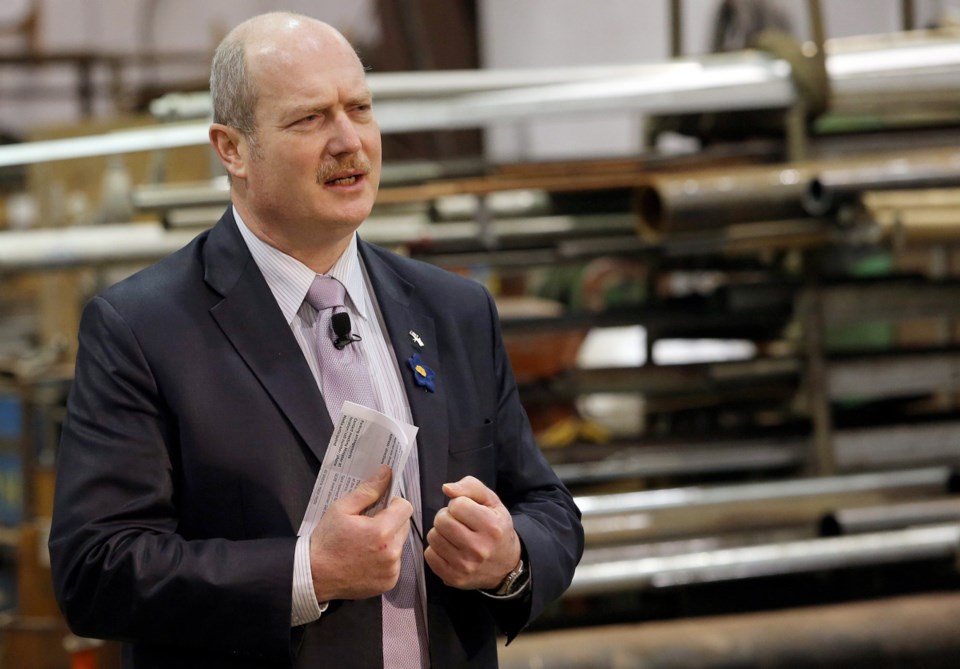 New Democrats in opposition were strident critics of the lack of guarantees for B.C. workers in the deal the B.C. Liberal government was trying to put together for a liquefied-natural-gas plant.
New Democrats in opposition were strident critics of the lack of guarantees for B.C. workers in the deal the B.C. Liberal government was trying to put together for a liquefied-natural-gas plant.
But there are no hard requirements in the NDP government’s deal with LNG Canada for B.C. hires.
The new estimates of how many B.C. taxpayers will be in the 10,000-strong workforce on the project are remarkably low. They are between 35 and 55 per cent, according to a government briefing note made public by the Liberal opposition on Tuesday.
On a list of key assumptions the government is making about LNG projects in general, the percentage of workers from B.C. is estimated at 55 per cent. But Liberal critic Mike de Jong said LNG Canada is putting the percentage much lower — at 35 per cent, a point not disputed by the government.
The government has also positioned itself in favour of expediting the hiring of temporary foreign workers, another point of contention the NDP raised while in opposition.
But the current finance minister, Carole James, herself criticized the lack of B.C.-hire requirements in the Liberal approach four years ago.
“It seems to me that it would be even more important for a premier, if they were really looking out for British Columbia, to make sure that there were jobs for British Columbians written into this agreement,” she said in the house in 2015.
“But no. There are no apprenticeship quotas, there are no training quotas and there are no job numbers that are in here.”
James urged the previous government: “You better make sure that local businesses have the opportunity to contribute, that local jobs are here.”
She was backed up by then-Opposition leader John Horgan on that point: “We should make sure … that if we invite someone to take that product from the ground, they hire British Columbians and Canadians to do that.”
James and de Jong clashed over the issue this week. She cited LNG Canada’s commitments to local hires, apprenticeship targets and training. But they are just in the form of a standalone letter. They’re not written into any deal with the government.
“Certainly, from my perspective, it was the goal that we went to negotiations with and a goal that I’m very pleased with,” she said.
Asked what the mechanism is to enforce the promises, she said: “It’s the ongoing relationship that we have with LNG Canada around the commitment here.”
She said the assumptions that just 35 to 55 per cent of workers on the project will be from B.C. are cautious and conservative, and she thinks it will be higher.
With at least 45 per cent of the workforce expected to come from outside B.C., the NDP has also made plans to expedite the use of foreign workers.
A cabinet decision note from 2017 discussed the use of foreigners and concluded that expediting their use would be perceived “extremely positively” by LNG Canada and seen as a signal of support for the project more broadly.
It was approved by Jobs Minister Bruce Ralston, who was among the NDP MLAs a few years ago who criticized the Liberals “for simply just trusting the proponent and taking them at their word.”
With B.C.’s low unemployment rate and the emerging skills shortages in the trades needed for the project, it would have been almost impossible to find 10,000 workers in B.C. to build an LNG plant.
Everyone involved in the project and the debate knows that, but few would acknowledge it. The NDP preferred to ride the patriotic “B.C. first” horse as far as it would take them through the years of LNG arguments. The emerging details show they started dismounting in a hurry within weeks of taking power. Now they’ve abandoned that position.
There’s potential for as many as 65 per cent of the workers to wind up arriving from outside B.C. and an unknown share of them coming from outside Canada.
James looked very uncomfortable ducking detailed questions about that, because she and her colleagues ignored the inevitability of it for years.



